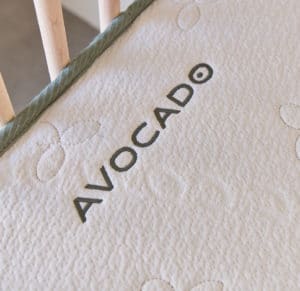All natural, GOLS certified latex can be a great choice for a crib mattress. Let’s break down the pros and cons of latex crib mattresses (and explain why Dunlop latex is better than Talalay latex for crib mattresses).
- Renewable resource
- Porous and disperses heat
- Antimicrobial, and doesn’t harbor dust mites
- Expensive
- Rubbery smell at first
Latex (natural rubber) is a renewable and recyclable resource increasingly used to make eco-friendly crib mattresses. Rubber trees can provide rubber serum for up to 30 years and the resulting latex is firm, bouncy, and durable. Although it isn’t as biodegradable as wool or cotton, natural latex can be recycled for use as underfloor insulation or other fill. And, eventually, it will biodegrade without releasing toxins into the environment, unlike polyurethane foam.
See also: The best non-toxic crib mattresses
Latex crib mattresses typically use molded latex Dunlop foam, which is chemical-free and slightly firmer than most polyurethane foam mattresses and also firmer than Talalay latex. Latex is particularly good for crib mattresses because it is porous and disperses heat. This porosity quickly becomes a problem, however, if the mattress doesn’t have a waterproof cover.
Latex is antimicrobial, resists mildew, and doesn’t harbor dust mites
The good news is that latex is naturally antimicrobial, resists mildew, and doesn’t harbor dust mites. It is also easy to care for as you can wipe down latex with warm soapy water, dab dry with a towel and let it air dry. Still, I’d highly recommend using a waterproof food-grade polyethylene cover for any crib mattress, along with easily removed and replaced wool puddle pads.
Latex crib mattresses are a little more expensive than some other mattresses made with natural materials, with the cost usually dependent on certifications. Relevant certifications include GOLS – the Global Organic Latex Standard – and FairRubber, which indicate that the product is made using certified organic rubber sourced in a sustainable way by workers who are well treated and properly paid.
Latex mattresses can have a rubbery smell at first, so it’s best to air them out for a few days before sleeping on them. It wouldn’t hurt to pair this airing out with a nursery air filter. This is not a sign that the mattress is off-gassing toxic chemicals, it is simply the natural smell of rubber and will dissipate within a few days.
When looking at mattresses, it’s important to determine if the latex is Dunlop or Talalay. As mentioned, Dunlop tends to be firmer feeling than Talalay which provides excellent soft support and pressure relief for adults but may be too soft for infants.
Why you don’t need to worry about latex allergy in crib mattresses
Some crib mattress manufacturers avoid using latex because of concerns over latex allergies in infants. This is an area where fearmongering appears to trump science, given that there’s no evidence of latex mattress use resulting in latex allergy in infants. While some infants do develop an allergy to latex, this is largely attributed to latex in bottle teats, pacifiers, balloons, nose cleaners, and medical equipment, with no documented cases of an allergy arising from sleeping on a latex mattress (R). Indeed, it is rather unlikely that an infant would even come into contact with latex from a latex mattress as these are typically covered in a layer of wool and cotton ticking and dressed with a waterproof cover and fitted sheets.
In addition, the latex used for medical equipment, pacifiers, gloves, condoms, and so forth is quite different to that used for mattresses. This latex, which is typically stretchy, is cold-dipped and still contains proteins that can trigger allergy. The types of latex found in mattresses undergo significant washing and a flash-heating or vulcanizing process that first eliminates a large amount of the proteins in the latex and then destroys any remaining proteins.
So, an infant seems much more likely to develop a latex allergy from repeated exposure to latex in a healthcare setting or even from using a pacifier, feeding bottles, or handling a party balloon than they are to have issues with a latex mattress. And, unless there’s a family history of latex allergy, or if an infant or caregiver has a known latex allergy and might touch the mattress in its uncovered state, there’s little reason to rule out a latex crib mattress.
Indeed, the only study I could find that looked at real-life exposure to natural latex found that there was no difference in the development of latex allergy in children who slept on a latex mattress compared to those who slept on a non-latex mattress (R). Most other studies look at immune responses when latex is frozen, crushed, ground up, mixed with solvents, and mixed directly with blood. Unless you’ve got some odd plans for your mattress, then, this exposure scenario seems rather unlikely.
Featured natural latex crib mattress

Avocado Crib Mattress
Highlights: One of LeafScore’s to picks, Avocado offer two crib mattresses, both made with GOTS organic certified cotton and wool, and GOLS organic certified latex. These crib mattresses have a smart two-sided design, with one firmer side safe for infants and then a slightly more plush side ideal for toddlers.